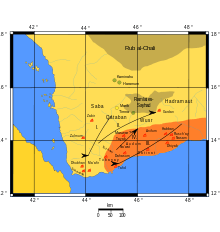Karib'il Watar
Karib'il Watar was probably the most important ruler of the early days of the Sabaean Kingdom. His name is composed of "KRB-El" One who carries out the instructions of El and "WṮR" one who destroys buildings.[1]
Inscriptions
Karib'il Watar, the son of Dhimar El Yanuf III who reigned in the early 7th century, changed his title from Mukarrib to Malik. He is mentioned in one of the longest and most important Sabaean inscriptions which is located on the Great Temple of Almaqah in Sirwah 40 kilometers west of Marib.[2]
Campaigns

The inscription in Sirwah which is composed of twenty lines describes the military campaigns led by Karib'il Watar. From the first line of the inscription, it seems the author was dazzled by his numerous extensive victories.
Karib'il started his campaigns by attacking western lands of Ma'rib, killing and capturing thousands of his enemies. Then he focused his attention on conquering of south-western sea ports and lands in order to weaken the Kingdom of Awsan.
He continued his advance to reach the lands of Awsan, which was controlling the southern regions up to shores of the Red Sea. Karib'il ordered his soldiers to shed their swords on Awsan's people, kill and capture thousands of them, and burn all their cities all the way to the sea.
Minaeans pose the next dangerous opponent. Therefore, he attacked their cities such as Annestum[note 1] (Nasha'an) and burned them. Afterwards, he besieged Nescus[note 2] (Nashaq) city for three years. The result of the siege was a humiliating defeat for Minaeans and the annexation of all their arable lands and dams, and a tribute have been imposed to the God Almaqah.
The last ever campaign was to north of Al Jawf near Najran. The outcome of the aggression was a landslide in which Karib'il killed five thousand, enslaved twelve thousand children, and seized more than two hundred thousand cattle.[3]
See also
Notes
- ↑ Mentioned by Pliny the Elder in his book Natural History. p. 151.
- ↑ Mentioned by Strabo during Aelius Gallus' expedition to Arabia Felix.
References
- ↑ Beeston, A.F.L.; Ghul, M. A.; Müller, W. W.; Ryckmans, J. (1982). Sabaic Dictionary. University of Sanaa, YAR. p. 78; 166. ISBN 2-8017-0194-7.
- ↑ McLaughlin, Daniel (2007). Yemen - the Bradt Travel Guide. The Globe Pequot Press. ISBN 1841622125.
- ↑ Magee, Peter (2014). The Archaeology of Prehistoric Arabia: Adaptation and Social Formation from the Neolithic to the Iron Age. Cambridge University Press. ISBN 1139991639.